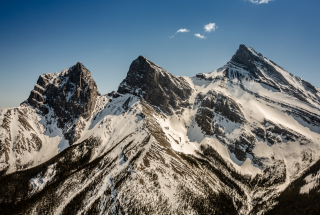Sacred Places: Connecting Land, Culture, and History
- Uncategorized
- January 11, 2023
- Share
“These mountains are our temples, our sanctuaries, and our resting places. They are a place of hope, a place of vision, a place of refuge, and a very special and holy place where the Great Spirit speaks with us. Therefore, these mountains are our sacred places.”
—Chief John Snow
There are many narratives about how the Îyârhe Nakoda (Stoney Nakoda) came to be in Chuwapchipchiyan Kudi Bi, the area now known as Canmore, says Elder John Snow Jr. His father, Chief John Snow, wrote the book on Stoney history—literally. “These Mountains Are Our Sacred Places” combines archival records, oral history, and the traditional wisdom of Stoney Nakoda Elders to recount the history of his people.
Some say they traveled across the prairies from the Dakotas, what is now North Dakota and South Dakota in the United States, says Snow Jr. Others believe they were created from these very mountains. “It is said that when creation occurred, we came out of the mountain, and at the end of time, we will go back to the mountain,” he explains. That’s what makes many of the much-loved destinations in Canmore and Kananaskis sacred for the Stoney people.
Take, for instance, Mount Yamnuska. Aptly called Îyâ Mnathka or “flat-faced mountain” by the Stoney Nakoda, the impressive rock wall towers above the entrance to the foothills; a mecca for First Nations as well as first-ascent seekers looking to conquer the mountain’s challenging south-facing slab—but for very different reasons.
“It is one of our holy mountains, our sacred mountain,” says Snow Jr., a place few Stoney Nakoda people visit except for in prayer and ceremony.
Down below, the rich and diverse valley floor offers a fertile ground for harvesting traditional, plant-based medicines. “The Elders have said that was our pharmacy. All our medicines are in the valley there,” says Snow Jr. Medicines like cedar, sage, sweetgrass, and tobacco that are used both for ceremony and healing. “Mother Earth provided for us.”
When Banff National Park was created in 1885, the Stoney Nakoda people were exiled; banned from visiting many of the sacred sites in the Bow Valley. “We were not allowed to pray at the mountain. We were not allowed to gather our harvesting medicines. We were not allowed to go to the healing waters of the hot springs. Those are our healing places,” says Snow Jr. The impacts were—and continue to be—devastating.
The Indian Residential School system only exacerbated the situation; forcibly separating children from their families, and forbidding them from acknowledging their Indigenous heritage and speaking their own languages. “Our culture was prohibited, censored. If we tried to speak in the Stoney language or talk about place names, we would be reprimanded, maybe even incarcerated,” says Snow Jr. The closest residential schools—the Morley Indian Residential School and the Morley Residential Day School—were in operation from 1886 until 1996. The Stoney Nakoda people continue to suffer the debilitating effects of residential schools.
“There’s a lot that has been suffered. And where there is a lot of suffering, much, much correction is required,” says Snow Jr.
—Chief John Snow
Fortunately, much of the heavy lifting has been done, says Snow Jr. When the Truth and Reconciliation Commission of Canada created the Calls to Action in 2015, they cleared the pathway for reconciliation with Indigenous Peoples.
For residents and visitors alike, it starts with acknowledging the Truth. “One of the most important things to know is that our Indigenous voices, our narratives, our stories have not been allowed to be shared—basically censored. So, we haven’t had the ability to share our deep history like other First Nations in Canada,” says Snow Jr.
The next step is learning about the history of Indigenous Peoples in Canada and taking action, says Snow Jr. He recommends reviewing the Calls to Action, picking one, and making it your personal call. “It’s important for the youth of this country to understand the history so they can make a contribution to change, and change the narrative to something that’s powerful and positive.”
Whether it’s learning about the history, tagging traditional place names, or promising to protect these sacred peaks, small steps can lead to big changes for those willing to walk the journey of reconciliation.
To further your learning, Snow Jr. recommends the following readings (available online or in person at the Canmore Museum Shop):
Additional resources:
Discover what makes Canmore and Kananaskis special, from the people who know it best. Think differently, travel more sustainably, and gain a deeper understanding of the mountains with Peaks Academy. Learn more.
